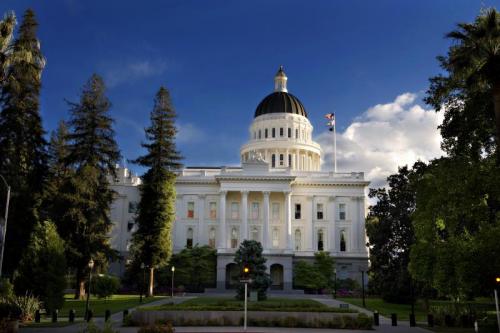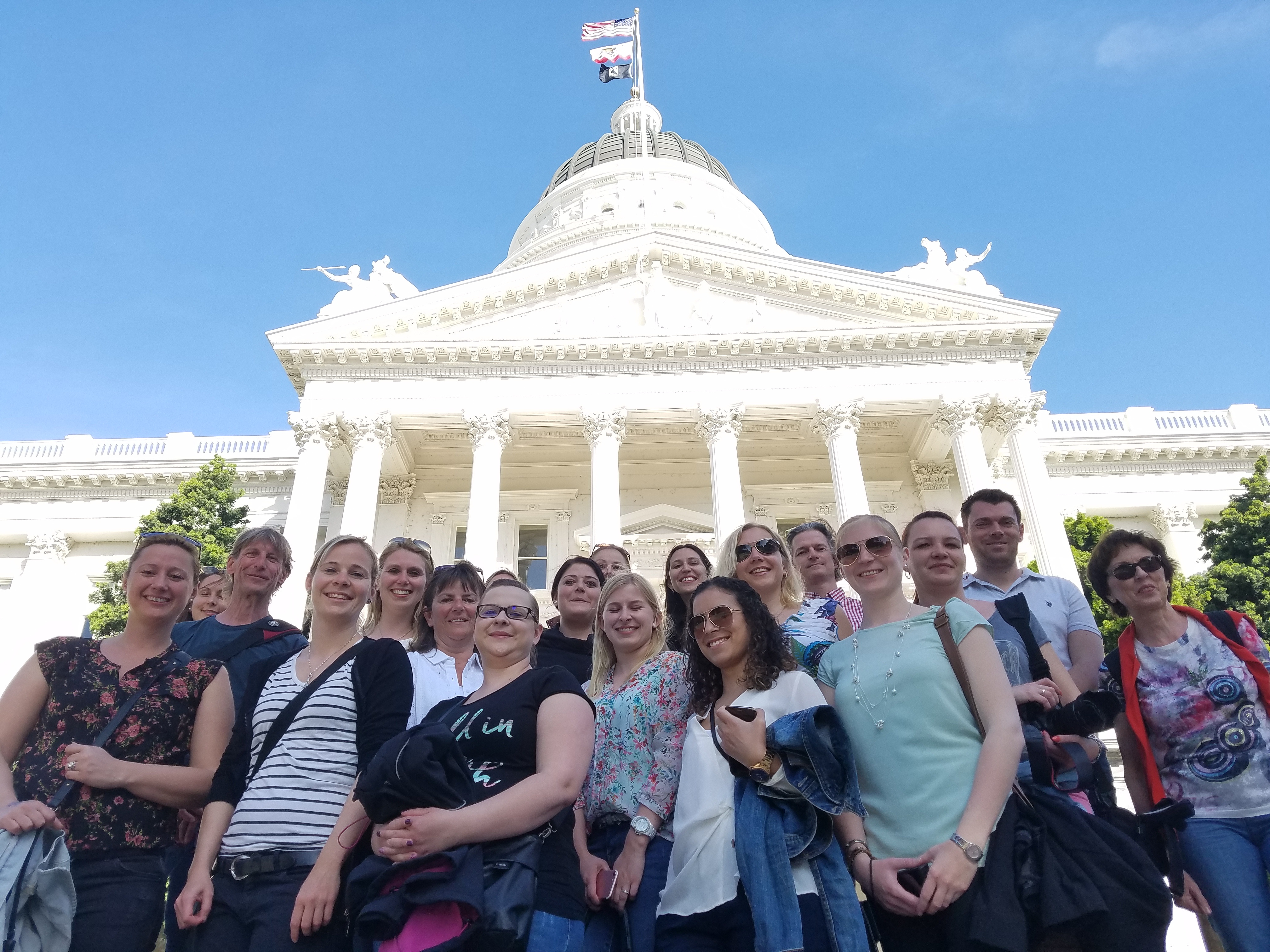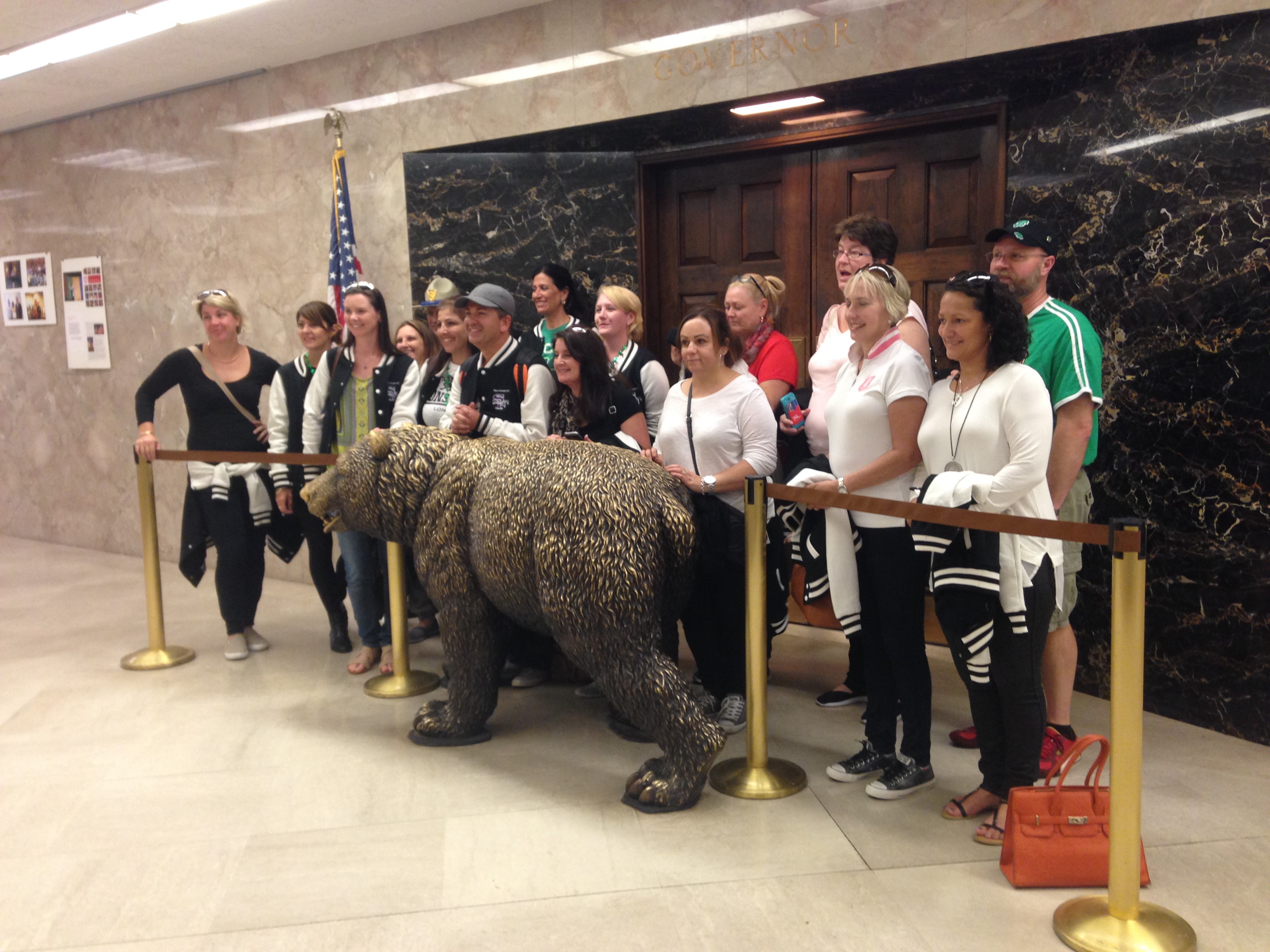- Skip to: Content
- Website Accessibility


Visit the State Capitol

At the State Capitol, the past, present and future of California interact with equal force. The building serves as both a museum and the state’s working seat of government. Visitors to the Capitol can at once experience California’s rich history and witness the making of history through the modern lawmaking process.
Find your representatives and visit their Capitol offices
California State Capitol 10th and L Streets Sacramento, CA 95814 (916) 324-0333
Driving Directions & Map Weekdays: 9 - 5 Weekends: CLOSED Admission is Free Tours Available Hourly Groups by Reservation
Museum Information and Tours
Upcoming Events Being Held at Capitol
Hosting an event at the State Capitol
Dining Services
Capitol Books and Gifts Open daily from 10:30 a.m. - 4:00 p.m. State Capitol Building, West Wing Basement (916) 324-0313
California Capitols
Shortly after the end of Mexican rule, Californians began to clamor for statehood. In 1849, a constitutional convention met at Colton Hall in Monterey and proposed a constitution, subsequently ratified by the people, which named San Jose as the first capital.
In December 1849, the first Legislature convened in a two-story adobe hotel in San Jose. The city was composed of little more than huts, tents and clapboard buildings, and the general discomfort did little to endear the city to the legislators.
In 1851 a generous offer from General Vallejo induced the legislators to move the capital to Vallejo where a frame building had been erected for their use. Since housing was virtually nonexistent, many of the Members managed to secure lodging on the steamer Empire, which remained moored at a wharf during the session.

Confusion and inconvenience again brought stormy cries for relocation. After convening in Vallejo in 1852, the Legislature moved to Sacramento to finish the legislative session.
In 1853, the Legislature returned to Vallejo only to find conditions as inhospitable as before. To an exasperated membership, an offer from the community of Benicia for the use of its new city hall proved irresistible, and a bill was passed moving the seat of government to that city, where the legislative session finished.
While the legislative quarters were adequate, it became increasingly evident that Benicia itself was too small to serve as the capital city. With this in mind, the Legislature determined that Sacramento would be the state’s capital and moved from Benicia in February 1854.
Sacramento offered its courthouse for immediate use and a building site for the permanent Capitol. Shortly after the close of the Session of 1854, the courthouse was razed by fire, but a new one was completed in time for the next session.
The new courthouse continued to serve as the home of the Legislature until 1869. This tenure was interrupted only once; during the winter of 1861–62 a severe flood prompted removal of the Legislature to the Exchange Building in San Francisco.
Construction on the permanent Capitol was begun in 1860, and, though not completed until 1874, the Legislature was able to occupy its Chambers in 1869. Except for a major “modernization” in 1908, the Capitol remained virtually unchanged until 1949 when additional space requirements resulted in the construction of the Capitol Annex. Completed in 1951, the Annex attaches to the east side of the old Capitol and houses legislative offices, committee rooms and the Governor’s offices.
In 1976, a total reconstruction of the building was undertaken to strengthen and reinforce the weakening structure. This monumental project was completed in January 1982, and the old Capitol, restored to its turn-of-the-century decor, was again occupied by the Legislature and opened to the public.
- Site Map ::
- Website Accessibility ::
- Privacy and Conditions of Use
- Back to Top
Copyright © 2024 State of California
Daily Schedule
Sunday, may 5, 2024, regular session.
The Assembly has adjourned until Monday, May 6th at 1:00 P.M.
First Extraordinary Session
The First Extraordinary Session has adjourned sine die.
Today's Hearings
No committee hearings are scheduled.
Quick Links
- Assembly Home Page
- Today's Assembly Events
- Assembly Daily File
- Legislative Calendar
- Assembly Fellowship Program
- Member & Staff Salaries
- Expenditure Reports
- Daily Journals
- Daily History
- Skip to: Content |
- Accessibility |
- Translate this website on Google Translate
California State Assembly
You are here
Visit the state capitol.
At the State Capitol, the past, present and future of California interact with equal force. The building serves as both a museum and the state’s working seat of government. Visitors to the Capitol can at once experience California’s rich history and witness the making of history through the modern lawmaking process.

California State Capitol 10th and L Streets Sacramento, CA 95814 (916) 324-0333
Driving Directions & Map Weekdays: 9 - 5 Weekends: CLOSED Admission is Free Tours Available Hourly Groups by Reservation
Museum Information and Tours
Upcoming Events Being Held at Capitol
Hosting an event at the State Capitol
Dining Services
Capitol Books and Gifts Open daily from 10:30 a.m. - 4:00 p.m. State Capitol Building, West Wing Basement (916) 324-0313

California Capitols
Shortly after the end of Mexican rule, Californians began to clamor for statehood. In 1849, a constitutional convention met at Colton Hall in Monterey and proposed a constitution, subsequently ratified by the people, which named San Jose as the first capital.
In December 1849, the first Legislature convened in a two-story adobe hotel in San Jose. The city was composed of little more than huts, tents and clapboard buildings, and the general discomfort did little to endear the city to the legislators.
In 1851 a generous offer from General Vallejo induced the legislators to move the capital to Vallejo where a frame building had been erected for their use. Since housing was virtually nonexistent, many of the Members managed to secure lodging on the steamer Empire, which remained moored at a wharf during the session.
Confusion and inconvenience again brought stormy cries for relocation. After convening in Vallejo in 1852, the Legislature moved to Sacramento to finish the legislative session.
In 1853, the Legislature returned to Vallejo only to find conditions as inhospitable as before. To an exasperated membership, an offer from the community of Benicia for the use of its new city hall proved irresistible, and a bill was passed moving the seat of government to that city, where the legislative session finished.

Sacramento offered its courthouse for immediate use and a building site for the permanent Capitol. Shortly after the close of the Session of 1854, the courthouse was razed by fire, but a new one was completed in time for the next session.
The new courthouse continued to serve as the home of the Legislature until 1869. This tenure was interrupted only once; during the winter of 1861–62 a severe flood prompted removal of the Legislature to the Exchange Building in San Francisco.
Construction on the permanent Capitol was begun in 1860, and, though not completed until 1874, the Legislature was able to occupy its Chambers in 1869. Except for a major “modernization” in 1908, the Capitol remained virtually unchanged until 1949 when additional space requirements resulted in the construction of the Capitol Annex. Completed in 1951, the Annex attaches to the east side of the old Capitol and houses legislative offices, committee rooms and the Governor’s offices.
In 1976, a total reconstruction of the building was undertaken to strengthen and reinforce the weakening structure. This monumental project was completed in January 1982, and the old Capitol, restored to its turn-of-the-century decor, was again occupied by the Legislature and opened to the public.
Find my Representative
- Assembly Roster
- By Your Address
- By District
Search for Legislation
- Bill Search
- California Law
- House Rules - HR 2 (Rendon)
- SCR 38 (Atkins) Recording Legislative Meetings
- Joint Rules - SCR 21 (De León)
Related Sites
- Governor of California
- Lieutenant Governor
- California State Senate
- Capitol Museum
- Secretary of State
- State of California
- Workplace Conduct Unit
Quick Links
- Assembly Home Page
- Today's Assembly Events
- Assembly Daily File
- Legislative Calendar
- Assembly Fellowship Program
- Member & Staff Salaries
- Expenditure Reports
- Daily Journals
- Daily History
- Download Acrobat Reader
- Download Media Player
- Download Quick Time

- Site Map ::
- Accessibility ::
- Privacy and Conditions of Use
- Back to Top
Copyright © 2024 State of California

Your Guide to Visiting the California State Capitol in Sacramento
The California State Capitol is a must-see stop on any Sacramento itinerary. Take a docent-led tour or a self-guided tour to experience California’s rich history and witness the making of history through the modern lawmaking process. It's a living museum dedicated to sharing California's past and working to build California's future. The grounds and building are open seven days a week for the public to explore.

The Capitol building Entering on the north side of the building (L Street side) you walk into the state's county exhibits. Each of the 58 counties has a display case showcasing its best of the best. As you continue through the hallways, you will enter the Capitol Rotunda, one of the most amazing architectural features of the building. The rotunda divides and unifies the Senate and the Assembly, the two houses of the California State Legislature, which occupy the south and north wings of the Capitol, respectively. This circular room is 53 feet in diameter and rises 128 feet from the basement of the building to the oculus at the apex of the inner dome. We like to count how many light bulbs are out, if any, and imagine the daunting task of replacing those!
As you roam the building, keep an eye out for the portraits of every California governor. Some stand out more than others, make sure not to miss governors Arnold Schwarzenegger, Jerry Brown (his first term) and Ronald Reagan, California's only governor to go on to become President of the United States.
Many people do not realize that you can visit both the Senate and the Assembly galleries, even when houses are in session. The architecture of both galleries reflects an open form of government, inviting visitors to sit and observe the Legislature in action. The red of the Senate and green of the Assembly are borrowed from our centuries-old British parliamentary heritage. If you look carefully on the ceiling of both galleries you'll notice an artist "signature," a tiny gargoyle sticking his tongue out -- just one of many artists' marks throughout the building.
Be sure to make your way down to the Governor's office to take a picture with the giant bronze bear, gifted by Schwarzenegger. On the first floor you can also peruse historic rooms restored to reflect various architectural and legislative eras representing the evolution of California's history and philosophies through the legacy of its leadership. Some historic rooms that served former governors, secretaries of state, and treasurers are now preserved to show visitors what the offices looked like at the turn of the 20th century.

The Capitol Grounds
Capitol Park is 40 acres spanning 12 city blocks. The park is filled with trees, plants and shrubs that have been gathered from all over the world. And it features some incredible memorials dedicated to different facets of California history. Capitol Park includes memorials for the Mexican-American War, Father Junipero Serra, firefighters, peace officers, the Spanish-American War, the USS California Bell, the Vietnam War and more. For detailed information about each monument, click here.
One of the most popular spots in the park is the World Peace Rose Garden. It was created as a sanctuary of peace, love and inspiration for people of all nations, cultures and religions. Fun fact, the southeast section serves as a test garden for the All-American Rose Selections. Visitors are afforded the opportunity to see new rose varieties before they are available to the public.

Don’t worry if you can’t see all of these attractions on your first visit to the California State Capitol. With each visit to the Capitol, you are likely to see something new or find yourself on a completely different track, from history to current events to other hidden gems. Adding a visit to the Capitol into your itinerary allows you to see a very important part of Sacramento and the state of California.
For more information on visit the Capitol, click here .
Lindsey Adams
To our enews, visitors' guide.
- Partnership
- Privacy Policy
1608 I Street, Sacramento, CA 95814
916-808-7777 | 1 800-292-2334
© 2024 Visit Sacramento. All rights reserved.
Would you like to accept cookies?

IMAGES